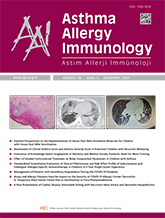


Objective: The avoidance of house dust mite (HDM) is crucial in the management of HDM allergies. We aimed to demonstrate the implementation and perspective of the parents whose children had HDM allergy/sensitization to HDM avoidance measures.
Materials and Methods: Parents of the patients with HDM sensitization were interviewed via telephone questionnaires.
Results: One hundred and three patients with asthma (73.8%), allergic rhinitis (AR) (77.7%) and/or atopic dermatitis (AD) (29.1%) aged four to 18 years were included in the study. Seventy-one patients had multiple allergic diseases (68.9%). Of the parents, 39.8% fully adhered to HDM avoidance measures, and their education status was as follows: 41.5% illiterate/elementary/middle school, 31.7% high school, and 26.8% associate`s degree/university. In addition, 32.2% of the mothers who were partially adherent (n=62) were illiterate or had graduated from elementary/middle school, 33.9% had graduated from high school, and 33.9% had an associate`s degree or had graduated from university. Forty-one (39.8%) mothers were working, and most of them (61%) had graduated from university or had an associate`s degree. Nearly half of the mothers who were partially adherent to HDM measures were working (n=32). In the multivariate analysis, the risk factors for partial adherence to measures was to be a working mother [OR:4.072, 95%CI: 1.350-12.882, p=0.013] and to have the belief that the measures were useless [OR:4.886, 95%CI: 1.499-15.923, p=0.008]. However, no relationship was shown between adherence to the measures and the severity of AR or AD, asthma control status and having multiple allergic diseases.
Conclusion: Full adherence to HDM avoidance measures was considerably dependent on the mothers` working status and belief in the ineffectiveness of the measures whereas there was no relationship to the severity of allergic diseases. This study also revealed how the education status of the mothers affected the adherence to allergen avoidance measures in real life.